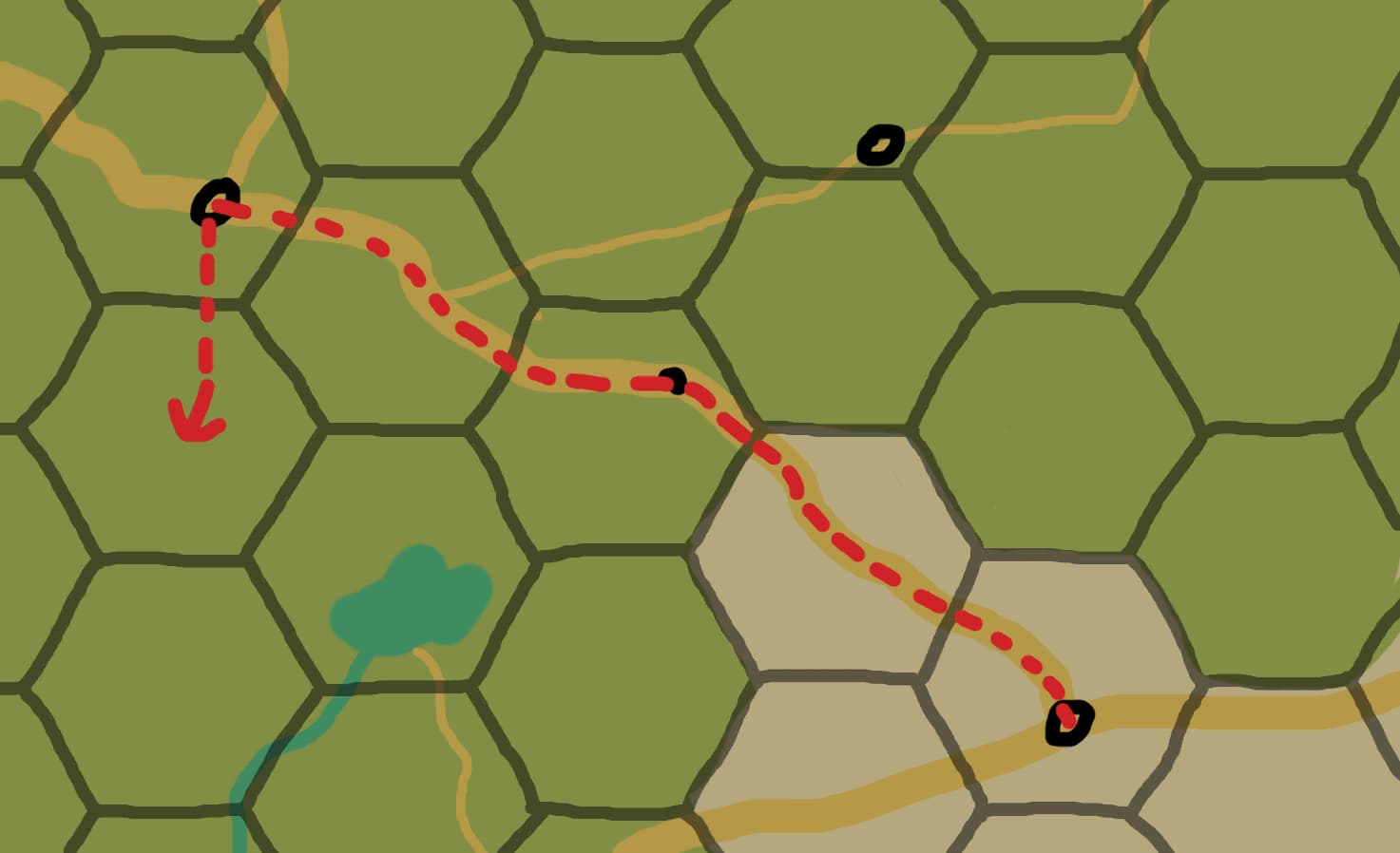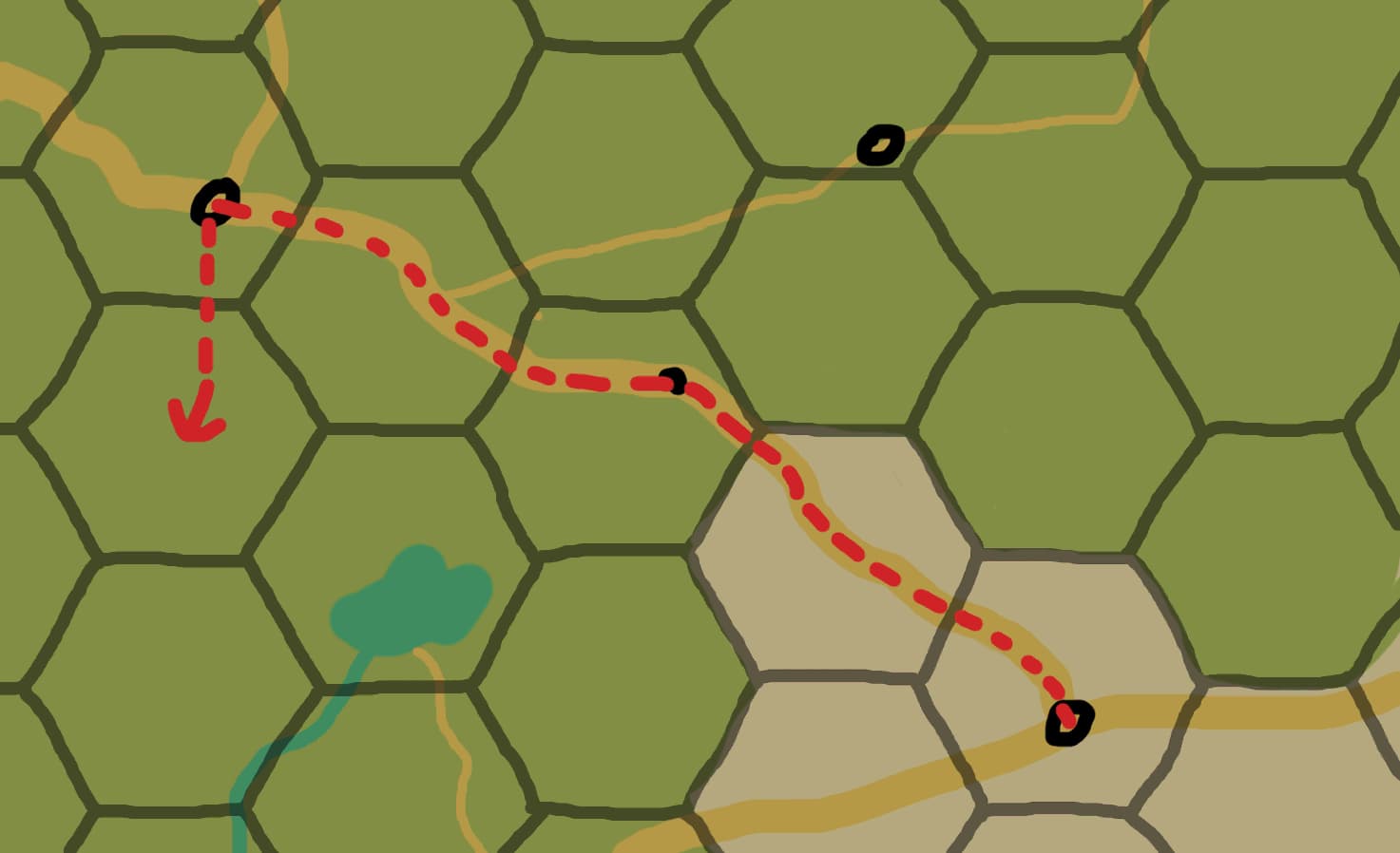18/12/2022
Are we there yet?

In this blog post I am going to set out a system of rules for thinking about and reasoning through overland travel.
First, let us acknowledge the system presented to us in Old-School Essentials for overland travel.
Overland Travel
Miles per day: The number of miles a character can travel in a day is determined by dividing their base movement rate by five. For example, a character whose base movement rate is 120’ could travel up to 24 miles in a day.
Terrain Modifiers
Some types of terrain modify the speed at which characters can travel:
- Broken lands, deser, forest, hills: 33% slower.
- Jungle, mountains, swamp: 50% slower.
- Maintained roads: 50% faster.
Forced March
If characters need to travel further in a day, they may engage in a forced march.
Speed increase: The distance travelled is increased by 50%. For example, a character that can normally travel 24 miles in a day could travel 36 miles.
Rest: After a forced march, characters must rest for a full day.
Now, this gives us an overview of overland travel, but it assumes a few things that may not be true in the fiction of your narrative:
- What if the players don't have a full days travel?
- What if the players are interrupted and stop part way?
- What if multiple terrain types are travelled across in the same day?
To solve these, a more granular system is needed. One which I will present here.
First we must ask how much of a day of overland travel is actually spent travelling. How does the party break up and divide their day? I am going to use an average day here, as obviously the exact daylight hours and flow of the game may shift depending on the season. Lets look at the following as a 'pure travel day'.
To do this, lets break the day into 12 sections, each of approximately 2 hours. This gives a nice more granular breakdown than the 24 hour period that the game uses by default for overland travel. I'm going to call these 'watches'.
| Watch | Rough times | Description |
|---|---|---|
| 1 | 6am–8am | Sunrise, Eating breakfast, taking down camp |
| 2–3 | 8am–Noon | The morning march |
| 4 | Noon-2pm | Lunch, resting |
| 5–6 | 2pm–6pm | The afternoon march |
| 7–8 | 6pm–10pm | Setting up camp, dinner, campfire stories |
| 9 | 10pm–Midnight | First watch, twilight to dark |
| 10 | Midnight–2am | Second watch, midnight |
| 11 | 2am–4am | Third watch, the graveyard shift |
| 12 | 4am–6am | Final watch, light before dawn |
This gives an example of what a full adventuring day might look like. Overall 4 watches (8 hours) have been spent on the road, and the rest has been spent resting and doing all of the other things one must do to be an adventurer in the wild. In order to forced march we need to increase our time on the road by 50%, so for this we can forgo lunch and half the evening camp period. Giving us 6 watches (12 hours) of on foot travel.
Now we have a system of watches, and a rough idea of what might transpire in a 'typical' overland travel day (and how this integrates with forced marching), we can summarise the following rules.
- A day contains 12 watches.
- A party can move 1/20th of their base movement rate in miles per watch. (1/4 of their daily movement rate).
- A party cannot move more than 2 watches in a row without resting, unless they engage in a forced march.
- A party cannot move more than 4 watches in a day, or 6 watches in day if they engage in a forced march.
These rules set out a nice easy way to allow a party to spend a fraction of their day travelling. Perhaps they want to travel from midday until nightfall in winter (4pm), this gives them 2 watches of travel.
Now, we can apply a cost in watches to various lengths of travel through terrain, rather than having to recon in miles. This allows us to abstract over the period of time the group wishes to travel.

Lets say we wanted to figure out a journey time on the above 6 mile hex.
First, they have to travel through half a hex of farmland. Then a full hex of farmland. Then 2 and one third of a hex of forest. All while travelling along a road. Because this is all along a road, it's all 50% faster. Then they want to travel through a hex and one third of forest without a road, which is 33% slower.
My party has a party base movement rate of 90', meaning they can move 18 miles per day, or 4.5 miles per watch. For the road portion of the journey, they are travelling 23 miles on the road. Their movement rate increase means they will be able to travel at 6.75 miles per watch on the road. It will thus take them 4 full watches (as we wont allow partial watches) to make it to where they plan on leaving the road. Then, they want to travel through the forest for 5 miles. Their movement rate here will be 33% slower, so 3 miles per watch. Thus it will take them 2 full watches.
This gives a total travel time of 6 watches. Thus they either need a full days travel, or a day with a forced march. As it would be a bad idea to forced march into the forest and need to rest a day out there, they probably better break this trip over two days.
This now gives them the freedom to choose where they do those 6 watches across the two days. Do they split it 3/3 and spend more time in town on each day, or perhaps they do 4/2 and arrive at their destination by lunch time.
Overall, to use this more granular watch based system, you need to know your parties movement rate in miles per watch, and you need to know what that is modified for each of 33% slower, 50% slower, and 50% faster.
Hopefully this system makes calculating your parties journeys a bit easier, and gives you a nice breakdown of what happens if they leave part way through a day rather than travelling full time.
It also gives you a nice roll table you can use to determine wandering monster encounters, lets look at the rules for these in overland travel in OSE.
Wandering Monsters
Frequency: A check is typically rolled once per day, but the referee may choose to make more checks: up to three or four per day.
Chance: The chance of encountering a wandering monster depends on the terrain being explored (see below).
Distance: Wandering monsters are encountered 4d6 × 10 yards away. If either side is surprised (see Encounters), this is reduced to 1d4 × 10 yards.
Chance by Terrain
- City, clear, grasslands, settled lands: 1-in-6.
- Aerial, barren, desert, forest, hills: 2-in-6.
- Jungle, mountains, swamp: 3-in-6.
This also faces the problem of knowing what terrain the party will be in when the encounter occurs.
To solve this, instead start by rolling a d12, this will tell you what time of day the wandering monsters might be encountered.
Then, roll a d6 to determine the encounter chance. Keep this number for later.
When the watch the encounter might be in comes up in the players day, whether they are still in town, or have set off on their journey, check the number you rolled for encounter chance against the chance in the terrain they are in at that time. If it is then appropriate create a random encounter.
For example, lets say I rolled a 2 for the encounter watch on the first day of their travels. Then a rolled a 1 fo the encoutner itself. If they decided to split the travel 3/3 they will not have set out yet by watch 2, and so would not face an encounter (assuming there are no wandering monster encounters in the settlement they are leaving from). If they decided instead to split it 4/2, then they would have set off for watch 2 and would be meeting an encounter on the road!
Related Posts
- Announcing Horizon, The End of RPG Content on This Website12/02/2023TTRPG
- Building My Ideal Basic D&D Setting, Alignments & Magic07/05/2022TTRPG
- Why My Orcs Are Monsters29/04/2022TTRPG
- A Genealogy Of Dungeons & Dragons & Old-School Essentials26/04/2022TTRPG
- There is almost always a better choice than an Ability Check13/07/2021TTRPG
- Response: Dungeon Antology Orthodoxies I12/03/2021TTRPG
- How I Run The Thief27/09/2020TTRPG
- When is it?22/08/2020TTRPG
- The skills you didn't know you had11/07/2020TTRPG
- What Is That Gem or Jewel?03/06/2020TTRPG
- Did I Hit?06/04/2020TTRPG
- YOU DIED... Would You Rather Not?12/03/2020TTRPG
- Which Saving Throw Should I Use?10/02/2020TTRPG
- So You Want To Buy A Person's Life?29/10/2019TTRPG
- Lost In Space, a Savage Worlds One Sheet30/04/2018TTRPG
- Gnoll Caverns, a Savage Worlds One Sheet16/04/2018TTRPG